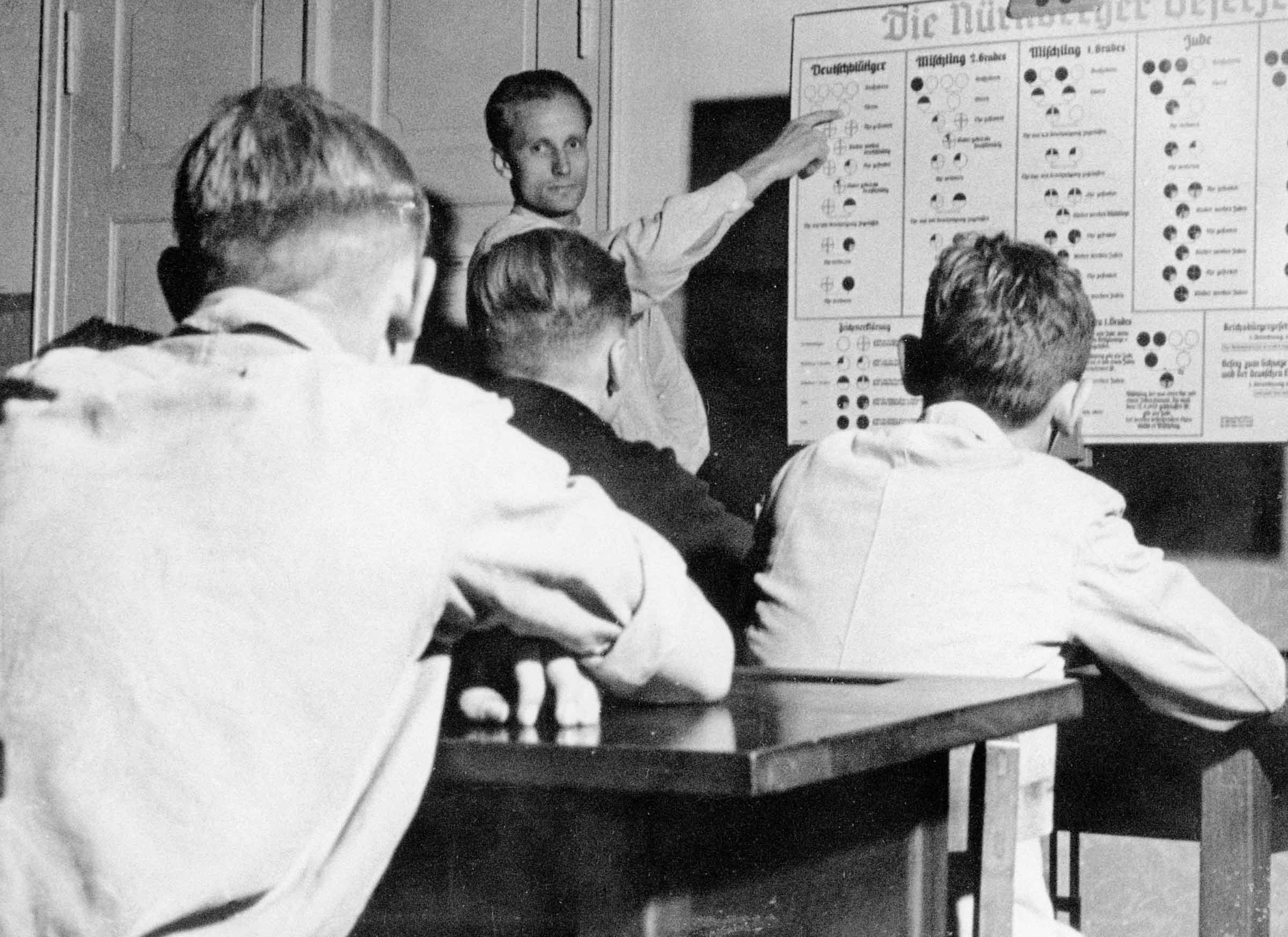Exclusion, Deprivation of Rights, Expropriations
Fueled by a racist ideology, enmity towards Jews is a main focus of the National Socialist German Workers’ Party. The party is founded in 1920 and takes control over the German Reich on January 30, 1933, with Adolf Hitler’s appointment as chancellor.
Simultaneously to their securing of their position through the use of terror, the country’s new leaders move to exclude Germany’s approximately 500,000 Jews from society, disenfranchising them politically and depriving them of their ability to earn a living. They accomplish this through a combination of political party actions, legal regulations and state measures. The National Socialists’ goal is to push Jews to leave Germany by making their lives miserable.
In June 1938, the Nazi regime intensifies its anti-Jewish measures: Shops in Berlin are defaced with graffiti and looted, and more than 2,000 Jews are arrested and sent to concentration camps in a nationwide police action aimed at “antisocial elements”.

SA member next to a poster with the inscription “Germans! Fight back! Don’t buy from Jews!” on April 1, 1933 in front of the Tietz department store in Berlin
The morning of April 1, 1933 sees the start of a nationwide boycott of Jewish businesses, doctors, lawyers and notaries organized by the Central Committee to Repulse Jewish Atrocity and Boycott Agitation under Julius Streicher, Gauleiter of the Bavarian region of Franconia. The police and the judiciary do nothing to curb these anti-Jewish actions.
The New York Times, Paris Office / National Archives, College Park, MD
SA member next to a poster with the inscription “Germans! Fight back! Don’t buy from Jews!” on April 1, 1933 in front of the Tietz department store in Berlin
The morning of April 1, 1933 sees the start of a nationwide boycott of Jewish businesses, doctors, lawyers and notaries organized by the Central Committee to Repulse Jewish Atrocity and Boycott Agitation under Julius Streicher, Gauleiter of the Bavarian region of Franconia. The police and the judiciary do nothing to curb these anti-Jewish actions.
The New York Times, Paris Office / National Archives, College Park, MD
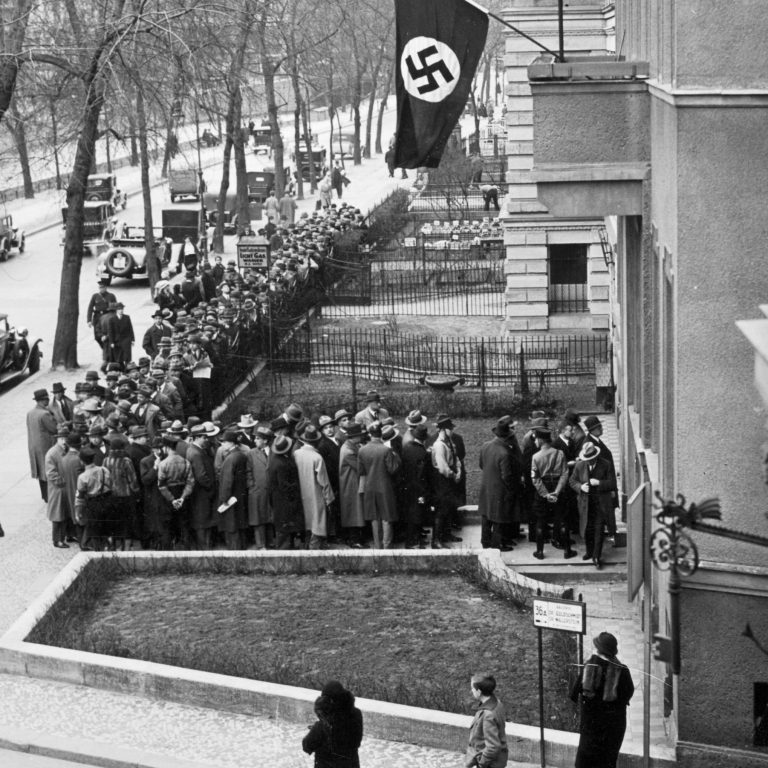
Jewish attorneys wait in front of the Berlin Bar Association for their re-admission, April 1933
The “Law for the Restoration of Professional Civil Service” of April 7, 1933 creates the legal basis for removing Jews from civil service jobs. The “Law on Admission to the Bar” deprives most Jewish lawyers of their membership. Reich President Paul von Hindenburg intervenes, but only “old lawyers” who were admitted to the bar before 1914 and veteran combatants from World War I may apply for re-admission.
SZ Photo, München
Jewish attorneys wait in front of the Berlin Bar Association for their re-admission, April 1933
The “Law for the Restoration of Professional Civil Service” of April 7, 1933 creates the legal basis for removing Jews from civil service jobs. The “Law on Admission to the Bar” deprives most Jewish lawyers of their membership. Reich President Paul von Hindenburg intervenes, but only “old lawyers” who were admitted to the bar before 1914 and veteran combatants from World War I may apply for re-admission.
SZ Photo, München
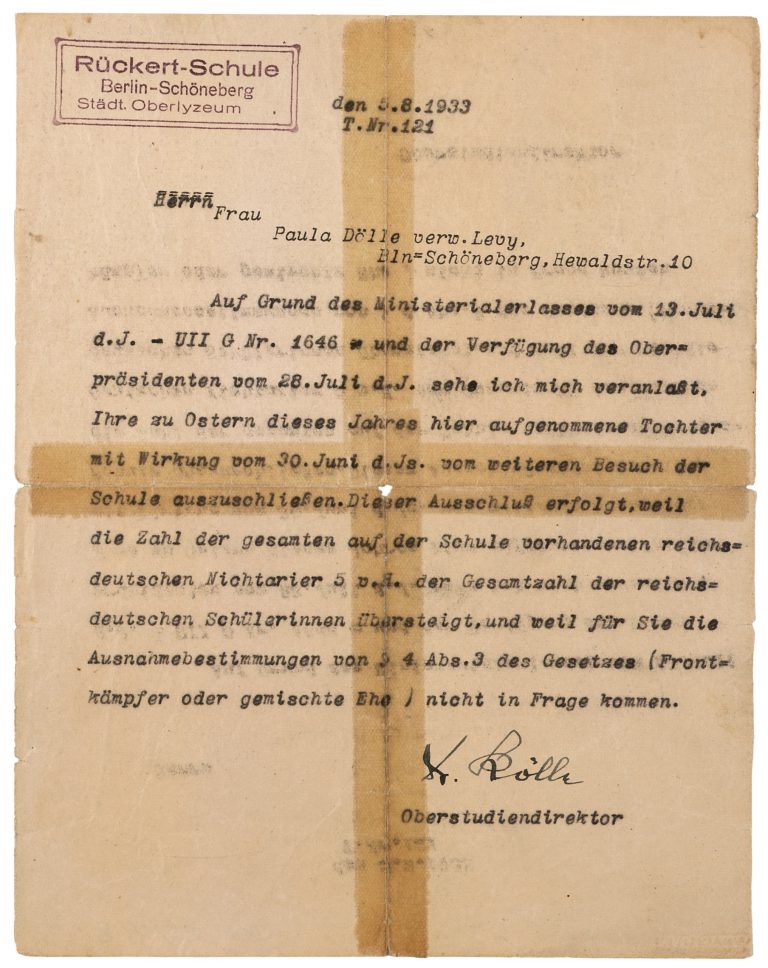
The Rückert School in Berlin-Schöneberg informs Paula Dölle about the expulsion of her daughter, Grete Myriam, Berlin, August 5, 1933
From April 23, 1933, onward, the “Law against the overcrowding of German schools and universities” limits the proportion of Jewish pupils and students to five percent. The bureaucratic tone of the letter that the school management sends to parents of affected pupils obscures the serious consequences for the children themselves.
Jüdisches Museum Berlin
The Rückert School in Berlin-Schöneberg informs Paula Dölle about the expulsion of her daughter, Grete Myriam, Berlin, August 5, 1933
From April 23, 1933, onward, the “Law against the overcrowding of German schools and universities” limits the proportion of Jewish pupils and students to five percent. The bureaucratic tone of the letter that the school management sends to parents of affected pupils obscures the serious consequences for the children themselves.
Jüdisches Museum Berlin
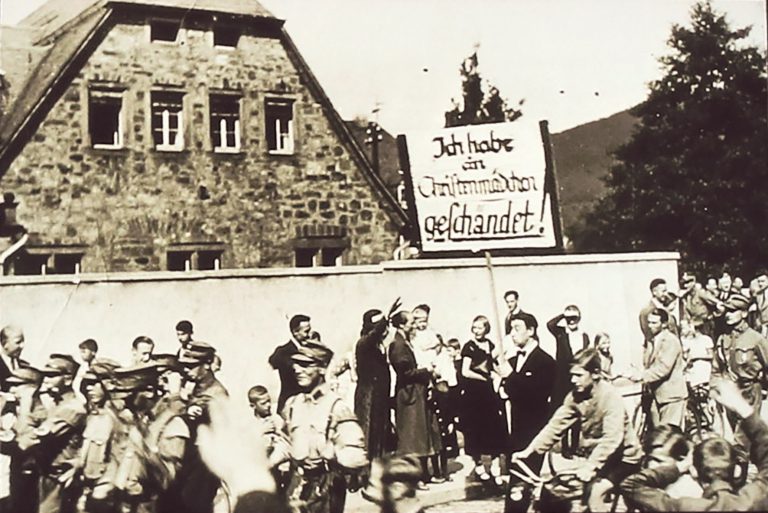
The SA parades a Jewish student through the city of Marburg with a sign saying, “I have defiled a Christian girl!” August 24, 1933
Even before the “Nuremberg Laws” are enacted, numerous places see attacks against Jews for alleged “racial defilement.” A rash of pogroms in smaller towns prompts many Jews to choose the anonymity of bigger cities, where they are less exposed to this form of persecution.
Archiv der Stabsstelle Presse- und Öffentlichkeitsarbeit der Stadt Marburg
The SA parades a Jewish student through the city of Marburg with a sign saying, “I have defiled a Christian girl!” August 24, 1933
Even before the “Nuremberg Laws” are enacted, numerous places see attacks against Jews for alleged “racial defilement.” A rash of pogroms in smaller towns prompts many Jews to choose the anonymity of bigger cities, where they are less exposed to this form of persecution.
Archiv der Stabsstelle Presse- und Öffentlichkeitsarbeit der Stadt Marburg
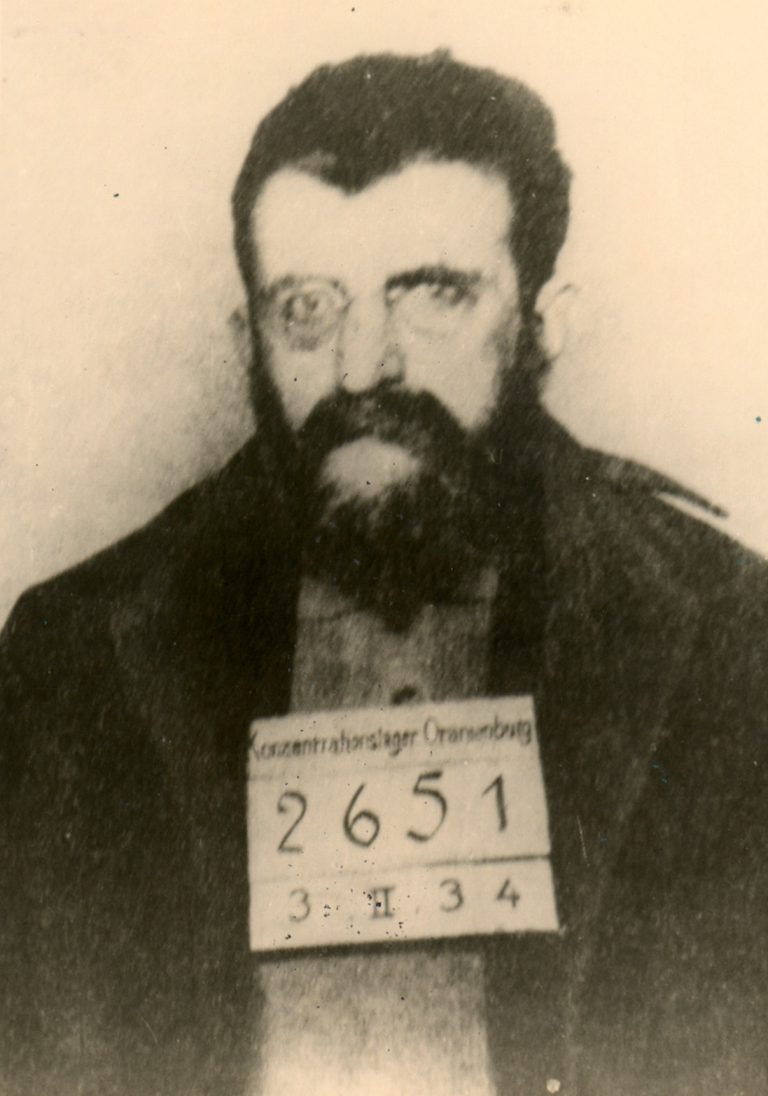
Prisoner photo, Erich Mühsam, Oranienburg concentration camp, February 3, 1934
People of Jewish background are particularly at risk if they share characteristics with other perceived enemies of the Nazi regime: The poet and anarchist Erich Mühsam is tortured and hanged by SS men in the Oranienburg concentration camp on July 9, 1934.
Bundesarchiv, Berlin, BildY 10-769-8113
Prisoner photo, Erich Mühsam, Oranienburg concentration camp, February 3, 1934
People of Jewish background are particularly at risk if they share characteristics with other perceived enemies of the Nazi regime: The poet and anarchist Erich Mühsam is tortured and hanged by SS men in the Oranienburg concentration camp on July 9, 1934.
Bundesarchiv, Berlin, BildY 10-769-8113
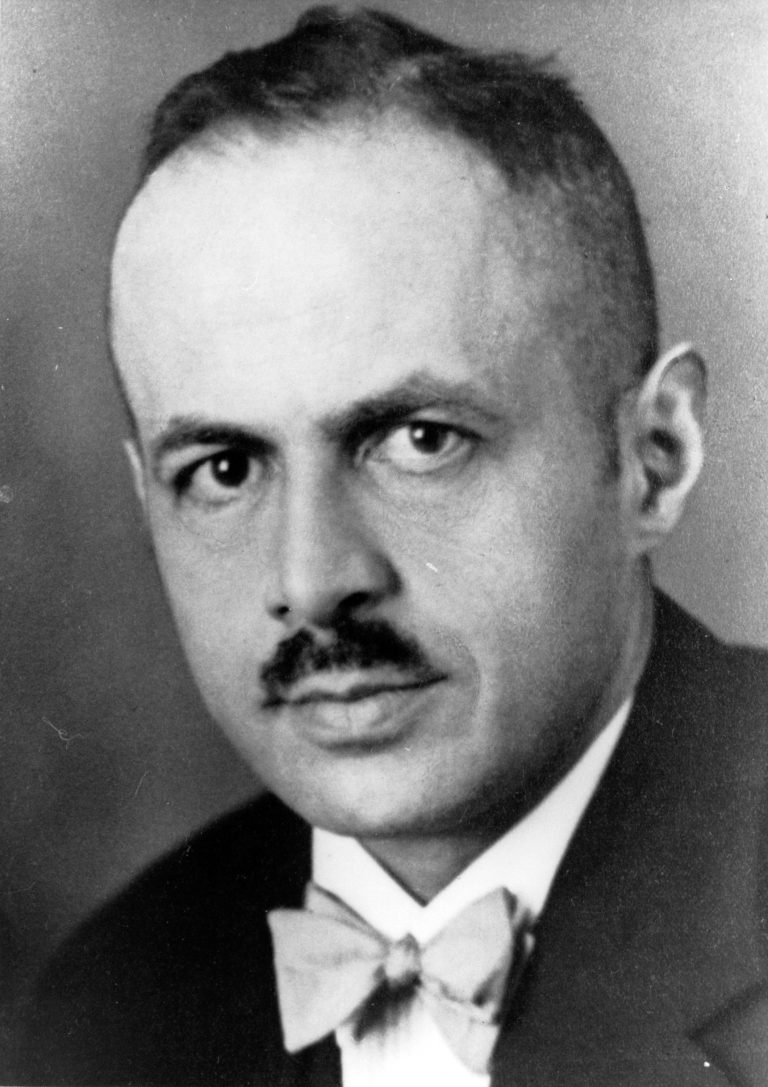
Friedrich Weißler, undated
People of Jewish background are particularly at risk if they share characteristics with other perceived enemies of the Nazi regime: Former District Court Director Friedrich Weissler – co-author of a Confessing Church critique of the Nazi regime – is incarcerated in the Sachsenhausen concentration camp on February 13, 1937. He dies there six days later, after being subjected to brutal torture.
Private collection
Friedrich Weißler, undated
People of Jewish background are particularly at risk if they share characteristics with other perceived enemies of the Nazi regime: Former District Court Director Friedrich Weissler – co-author of a Confessing Church critique of the Nazi regime – is incarcerated in the Sachsenhausen concentration camp on February 13, 1937. He dies there six days later, after being subjected to brutal torture.
Private collection

“Aryan Easter Eggs Back Again”
Official harassment and boycott actions by non-Jewish competitors force Jews to close their businesses, such as the egg trade, even before the enactment of laws officially excluding them from professional life.
Der Angriff, April 10, 1936
“Aryan Easter Eggs Back Again”
Official harassment and boycott actions by non-Jewish competitors force Jews to close their businesses, such as the egg trade, even before the enactment of laws officially excluding them from professional life.
Der Angriff, April 10, 1936
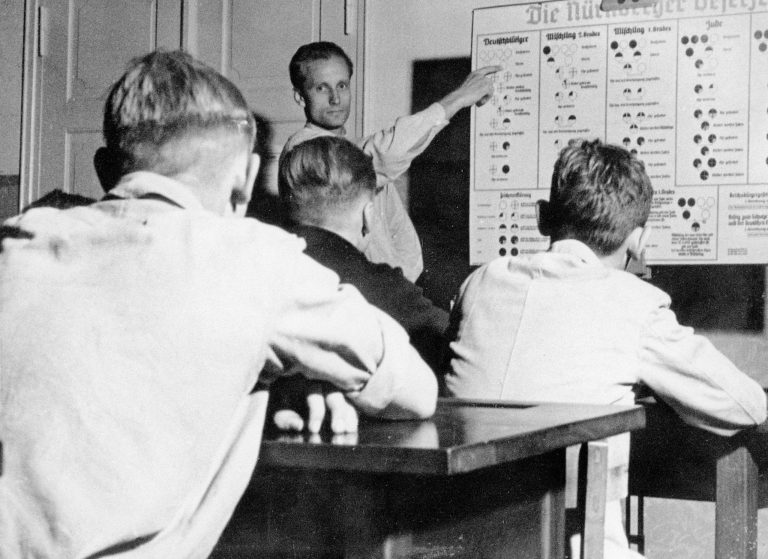
The “Nuremberg Laws” are explained during an “ideological training” program in the Hitler Youth camp at Hohenelse in Brandenburg, 1937
According to the “Reich Citizens Act,” announced at the NSDAP party conference in Nuremberg in 1935, one’s Jewishness is determined by the religious affiliation of one’s grandparents. The act declares Jews to be second-class citizens. The “Blood Protection Act” makes sexual relations between “Jews” and “gentiles” a crime; special courts convict numerous Jewish men.
SZ Photo, München
The “Nuremberg Laws” are explained during an “ideological training” program in the Hitler Youth camp at Hohenelse in Brandenburg, 1937
According to the “Reich Citizens Act,” announced at the NSDAP party conference in Nuremberg in 1935, one’s Jewishness is determined by the religious affiliation of one’s grandparents. The act declares Jews to be second-class citizens. The “Blood Protection Act” makes sexual relations between “Jews” and “gentiles” a crime; special courts convict numerous Jewish men.
SZ Photo, München
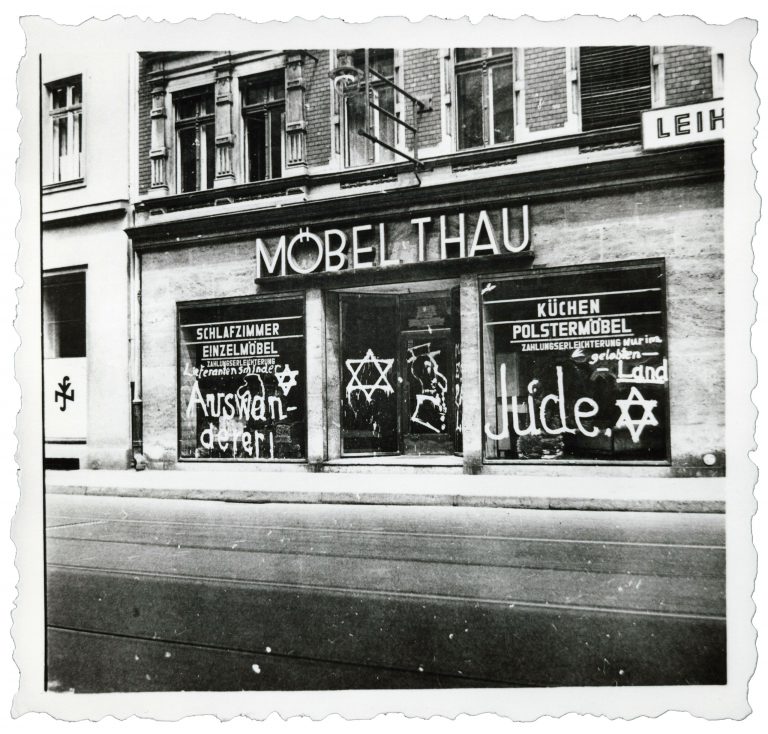
The furniture store Thau vandalized with antisemitic graffiti, Berlin, June 19, 1938
Jewish businesses are defined legally for the first time in the “Third Ordinance to the Reich Citizens Act” of June 14, 1938. A few days after the law’s passage, Berlin sees a pogrom that in hindsight can be interpreted as a kind of dress rehearsal for the events of November 1938: Jewish-owned shops across the city are vandalized with graffiti, and some are looted.
Centrum Judaicum, Berlin
The furniture store Thau vandalized with antisemitic graffiti, Berlin, June 19, 1938
Jewish businesses are defined legally for the first time in the “Third Ordinance to the Reich Citizens Act” of June 14, 1938. A few days after the law’s passage, Berlin sees a pogrom that in hindsight can be interpreted as a kind of dress rehearsal for the events of November 1938: Jewish-owned shops across the city are vandalized with graffiti, and some are looted.
Centrum Judaicum, Berlin







